New Zealand 2019: Beautiful Country
New Zealand had been on my travel list for a while because of it reputed physical beauty and good governance: it has become the movie set for films that need a dramatic geographic backdrop; and, together with Nordic countries and Australia, surveys consistently place it is among the best governed countries in the world. But I felt it was far and remote and so I kept putting off visiting.
It’s Prime Minister’s, and the country’s, response to the horrible terrorist attack on two mosques in Christchurch on March 15, 2019, when 51 people were killed and another 49 injured, prompted me to visit now in sympathy and admiration.
After the attack, the Prime Minister, Jacinda Ardern, said “Racism exists, but is not welcome here”….”Violence and extremism in all its forms, is not welcome here.” “Many of those who will have been directly affected by this shooting may be migrants to New Zealand; they may even be refugees here.”…. “They have chosen to make New Zealand their home, and it is their home. They are us. The person who has perpetuated this violence against us, is not. They have no place in New Zealand. There is no place in New Zealand for such acts of extreme and unprecedented violence.”……“We cannot know your grief, but we can walk with you at every stage. We can and we will surround you with aroha, manaakitanga, and all that makes us, us.” She used Maori words that mean kindness, compassion, and generosity.
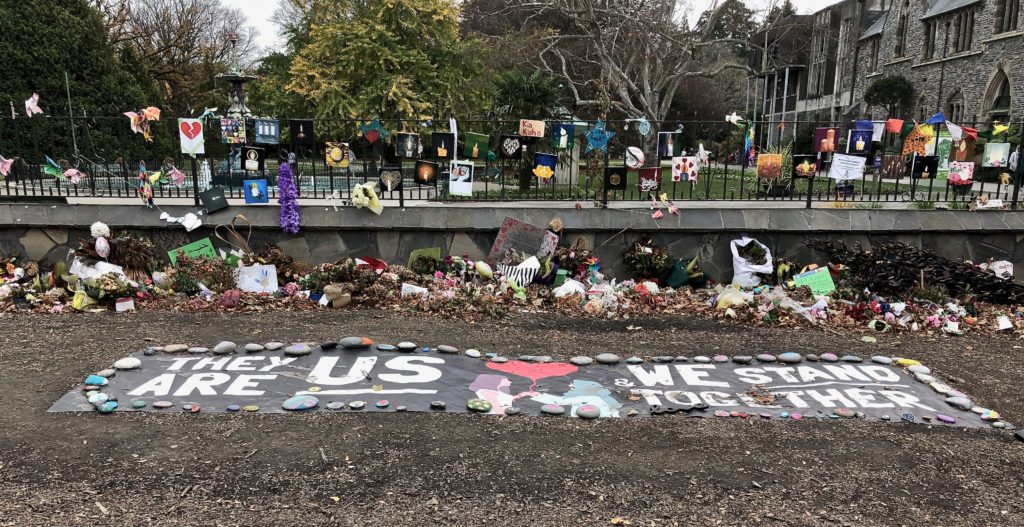
Memorial for terrorist attack.
Less than a week after the attacks, Ardern’s government announced a ban on military-style weapons. Even before the terms of the ban were worked out, Ardern encouraged people to begin surrendering weapons to the police, and several dozen people did. The gun ban became a matter of political agreement, rather than an emergency measure or a restriction imposed by the government. This is a shining example of leadership and good governance, sadly absent now in the world. In my albeit brief conversations with locals, talking to our guides and asking for directions and such, New Zealanders were warm, polite and informative, affirming the prime minister’s words.
Auckland turned out not to be that far after all, just an hour longer flight from San Francisco than to London. Although I was wrong about how far it is, I was not wrong about the travel distances within the country. I figured they would be too much for me to drive alone in three weeks. Besides, I would be watching the road rather than the scenery, one of the main reasons for visiting. After much hesitation, I decided to join a guided tour, a mode of travel I don’t appreciate partly because tours have a rigid schedule, and travelers don’t have a chance to meet locals other than the tour guides.
History
New Zealand is a young country, formed in its present state geologically just 10,000 years ago, and politically in 1840. Volcanoes in the North Island and a long range of mountains in the South Island have created dramatic landscapes, and earthquakes continue to reshape both Islands. Maoris came here in waves from Polynesia starting in the late 13th Century, and Europeans in the late 18th and early 19th Centuries. The Treaty of Waitangi apparently resolved the conflict between the older settlers and newer migrants. But it did not, as the two sides had a different understanding of the brief three-clause treaty. Land wars ensued resulting in confiscations of land from Maoris, and dodgy sales by them and acquisitions by Europeans occurred as well. Since about 1975 measures of restitution have resulted in a series of settlements adding up to almost a billion dollars. The only Maori I was able to discuss this with was our guide for the South Island and, in his opinion, the matter has been resolved satisfactorily. The Maori language and culture are officially and informally an integral part of New Zealand as the prime minister’s speech suggests. Nevertheless, Maoris are a higher proportion of the poor, homeless and the unhealthy than their share of the population.

Auckland Museum: Maori Meeting House
After the change in immigration regulations in the 1990s, Europeans are now about two-thirds of the population, Maoris are 15 percent, and Asians and Pacific Islanders about 19 percent. New Zealand is urban, about 60 percent of the population of 5 million lives in cities, and Auckland, the largest, has one-third of the country’s people.
Cities
I noticed that the guided tour did not allocate much time to cities so I arrived in Auckland three days before it started. I wanted to at least get a better feel for the largest city. Set among extinct volcanoes, between the Tasman Sea and the Pacific Ocean, with several inlets, miles of rivers and streams, and surrounded by rain-forested hills, its a scenic international city with a diverse population of 1.7 million people and 135,000 yachts. In the central area, shops and restaurants offer goods and cuisines from all over the world, especially Thai, Chinese, Indian and Italian.
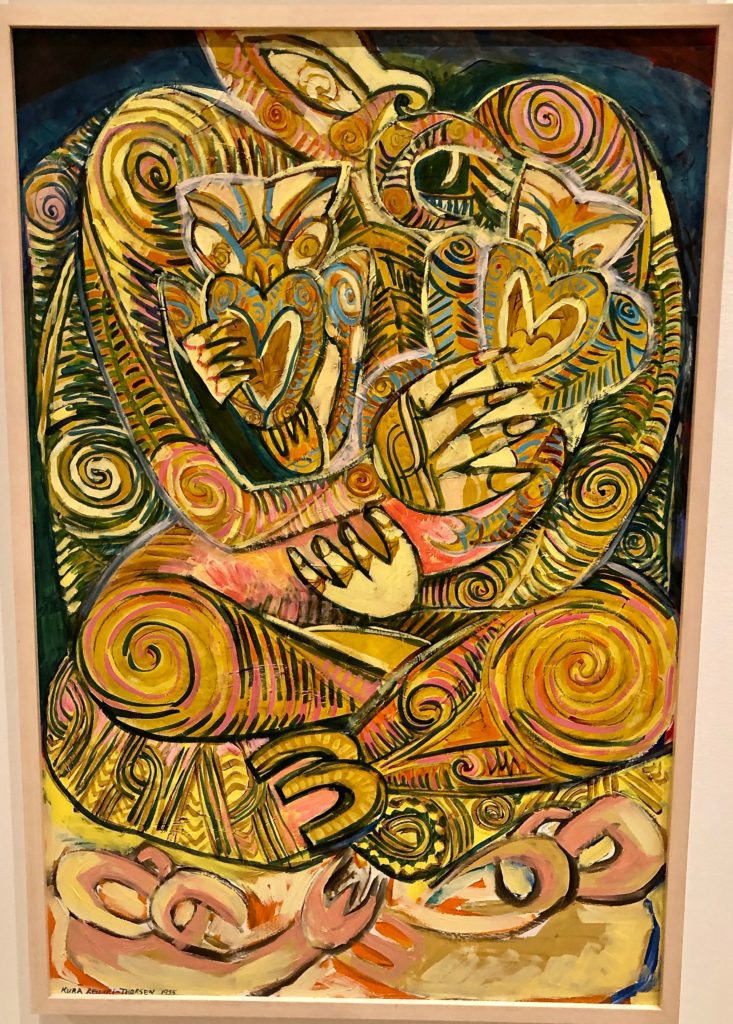
Auckland Art Gallery
The city has nurtured its history by caring for historic buildings and monuments, and provides ample recreation space with well-tended parks, bursting with colorful flowers. Its War Memorial Museum and Auckland Art Gallery had exhibits telling the story of its peoples from the beginning to modern times. The country’s Maori beginnings are shown in the magnificently carved Meeting House and Waka (war) canoe, woodcarvings and in paintings. The contribution and sacrifice the country made to two world wars is poignantly remembered as well. The Wallace Collection, housed in a mansion in the outskirts of town, reminiscent of Kenwood in London, had remarkable modern art, and lovely gardens and a café. By chance, while visiting Auckland University, the county’s top rated, I found myself among students and parents celebrating graduation in a park adjoining the campus.

Auckland Domain
With the advice of friends I lodged at a hotel in Devonport, an upscale suburb that is a ten-minute ferry ride across the bay from downtown Auckland. I took a tour of the suburb, along the shore and up a hill for a great view, passing many remarkable Victorian style houses with intricate, decorative woodwork. My hotel, the Esplanade, is a heritage property built in 1903, modeled after Victorian hotels in Brighton, with ornamented parapets and elaborate plasterwork, but updated rooms. As it was just across from the ferry building, the views of the city were superb. Its pub was gathering place for older locals with whom I enjoyed listening to music by an aging duo one evening. By third day of my stay, during my morning walks along the shore sipping Flat White Coffee, I came to be on nodding terms with early customers at the nearest café and joggers. New Zealanders are unusually well caffeinated with espresso-based coffee drinks.
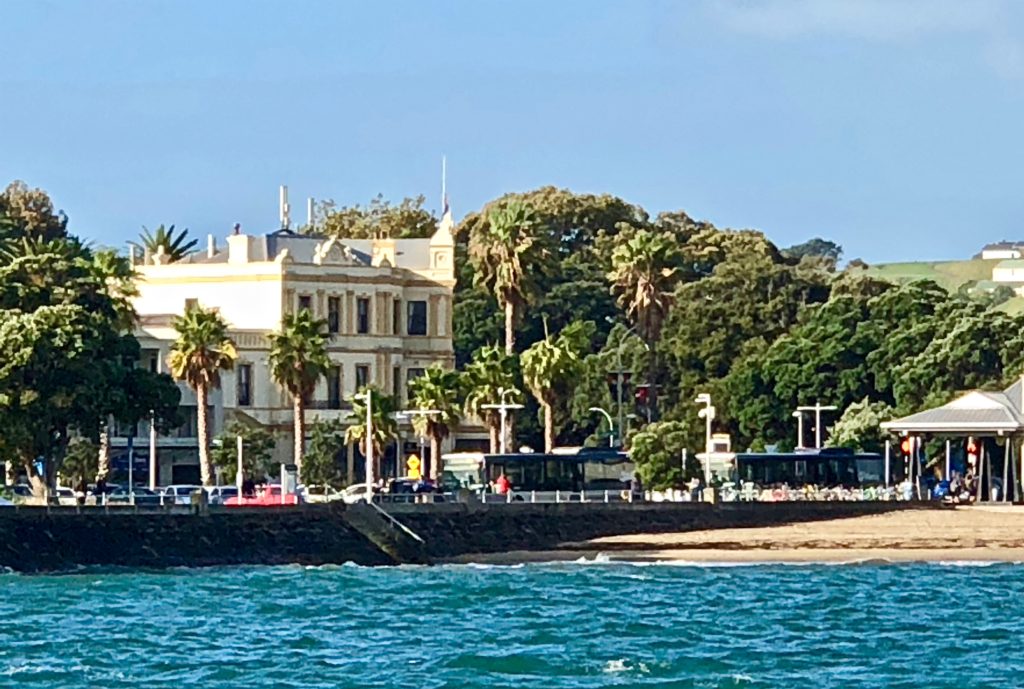
Esplanade Hotel, Davenport.
One afternoon, I took a longer ferry ride to Wiheke Island to visit a few wineries. It is in a gulf to the east of Auckland and partially protected from the colder and wetter winds, making it drier and warmer, similar in climate to the Rhone region of France, and its stony clay soil is rich in minerals. I particularly enjoyed the opulent Syrah at Tantalus, and the lean and fragrant Pinot Noir at Mudbrick Vineyards. Just the views at sunset of the vineyards and Auckland in the distance would have been worth the trip, but the excellent wine was a welcome surprise.
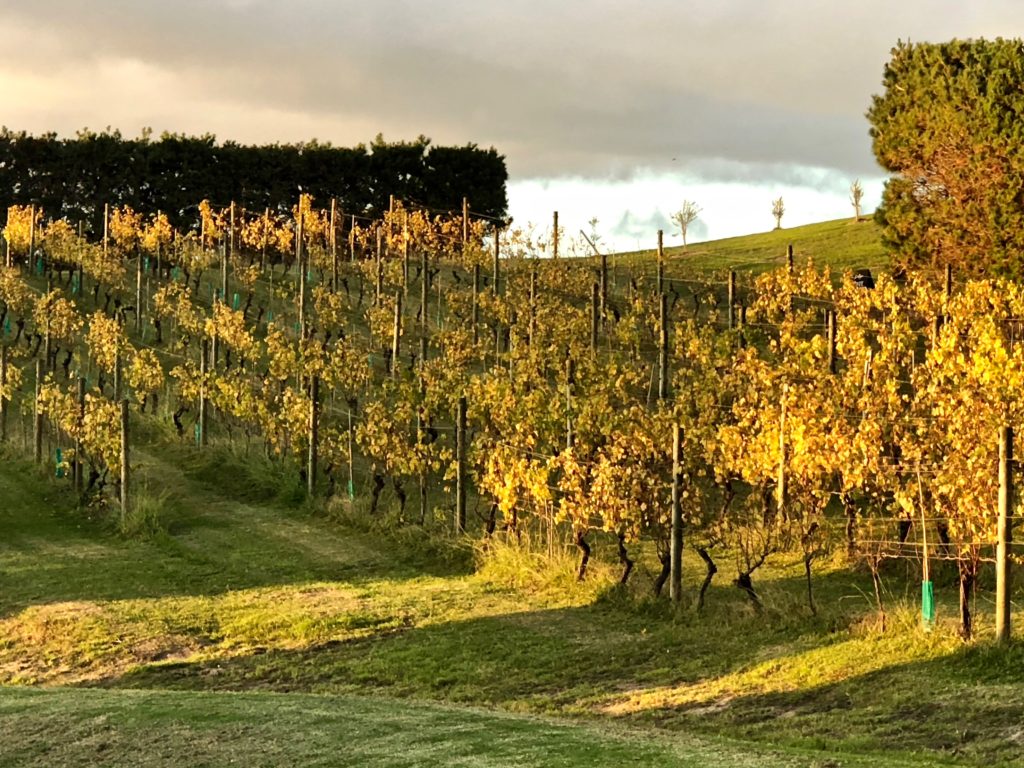
Waiheke: Mudbrick winery at sunset.
The guided tour included a drive through the main sights of Wellington, but did not give me much time to explore on my own. Still, an afternoon and evening of walking around the downtown area of the windy city gave me a taste of its urbanity and modern cuisine (see below). It is also an international city and, as the capital of the country, houses the legislature and national bureaucracies. It is set on hills rising from the Cook Straights, from where the wind funnels in. A guided tour of Te Papa, the National Museum and Art Collection, was the highlight. The Maori carvings and artifacts were striking and a special exhibition of New Zealand and Australia’s participation in the Gallipoli action during WW I was an informative and moving presentation with life-size sculptures of soldiers in action.

Wellington View
Although the South Island of New Zealand is about 30 percent bigger than the North Island, it has just one-third of its population. Its largest city is Christchurch, originally sponsored by the Church of England in 1850, and built in the architectural style of that period around its museum and lovely botanical gardens. Remnants of bouquets of flowers were at the entrance, placed there as a memorial for the terrorist attack on March 15. The city was devastated by earthquakes in 2010 and 2011 and is still being rebuilt. Its downtown area has rebounded with shiny new glass fronted buildings housing shops, cafes and restaurants, but its cathedral is cordoned off, waiting to be rebuilt.
Guided Tour Route
From Auckland, we drove north to the Bay of Islands, passing through Kauri forests, and small towns, sometimes hugging the sea. Kauri logging was an important early economic activity and the museum exhibiting is contribution gave an excellent idea of the prevailing living and working conditions, including reproductions of a boarding house, sawmill, Victorian home, and furniture. Our main destination was the Waitangi Treaty grounds on one side of the Bay of Islands, a little south of Doubtless Bay where Captain Cook first landed in 1769. Situated on a hill overlooking the bay, the treaty between the British Crown and Maori chiefs was signed there in 1840. It is where the modern nation of New Zealand was born. The small Treaty House has been maintained and a Maori Meeting House was erected nearby for the centenary in 1940, together with a 115 ft war canoe further down in the cove.
As whale and seal hunting picked up, the first European settlement was in Kororareka, renamed Russell, across the Bay from Waitangi, now a cute tourist town of just 2,000 people. It was the first capital of New Zealand, but for just a few months before Auckland got that privilege in 1841. It has the first French Catholic Mission (Pompallier) and the oldest surviving Anglican Church, to which Charles Darwin made a donation during his visit. He was not impressed by New Zealand, by the way.
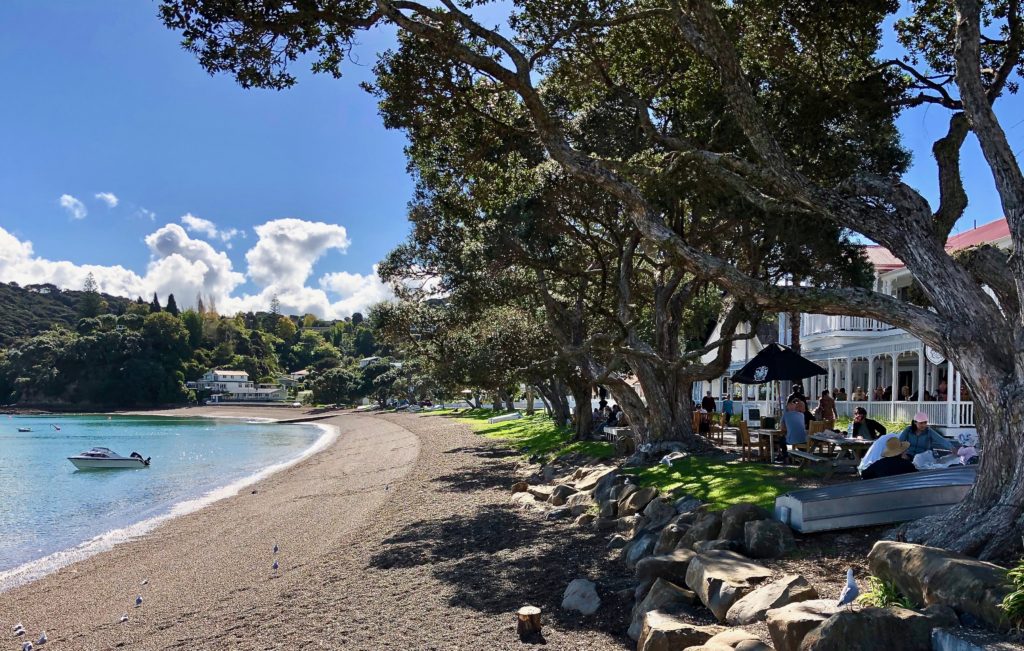
Russell: Bay of Islands
The scenery around the bay from any viewpoint was stunning, and especially from a cruise, looking at the mainland or islands on both sides at times, a few of them inhabited and cultivated, and others still rocky and wild. We were lucky to also spot a few dolphins, penguins and seals
Driving back South, after a night in Auckland, we drove to Rotorua, stopping for a tour of the 12 acre movie set at Hobbiton where “Lord of the Rings” and the Hobbit movies were made. It is a magical recreation of a shire, paths leading to tiny houses with small colorful doors and mini-sized laundry hanging to dry outside, set in lush green undulating country replete with trees and flowers. The sheep wandering around the hillsides were real though.
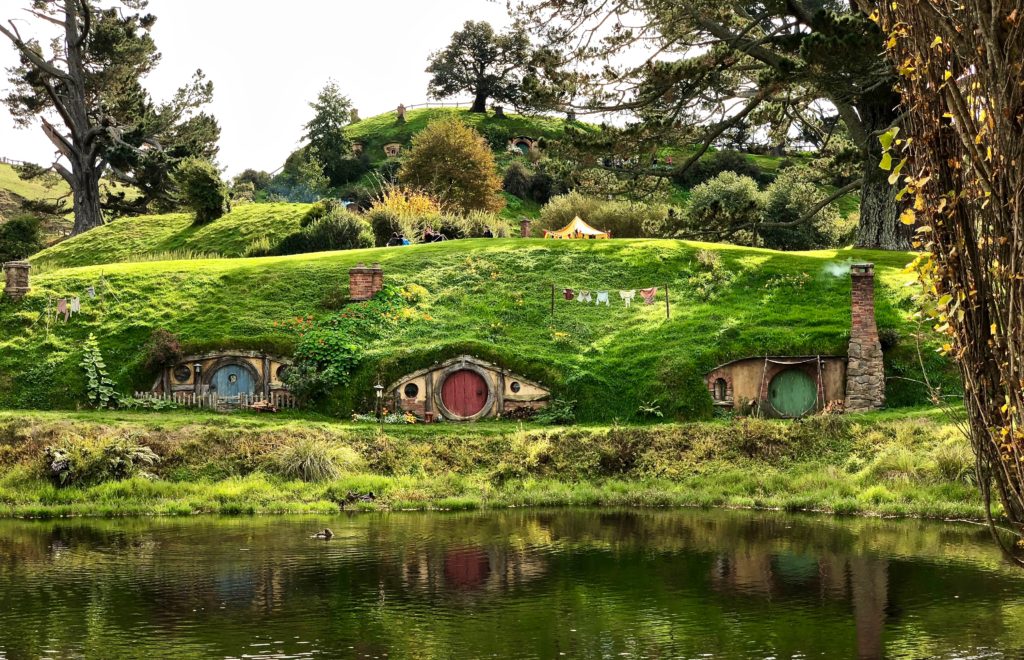
Hobbiton: Movie set
Further down the North Island, we stayed in Rotorua at a hotel beside the eponymous lake. This area is the center for Maori culture and arts and also New Zealand’s most active geothermal region. The town smells of sulfur, but a resident I spoke to said he doesn’t notice it anymore. The steam rising from the lake in the morning wasn’t mist and that was most obvious at the Te Puia geysers with steam clouds sizzling and mudpools bubbling.

Rotorua: Geyser
Nearby, we were guided through Maori carving and weaving schools trying to keep those crafts alive, followed by a greeting ceremony and dance performance. Some of us participated in the Haka, the war dance, now performed by the country’s world-champion rugby team just before beginning a game to intimidate its opponents. The evening ended with a Hangi, a Maori feast, with food cooked in a pit with heated rocks.
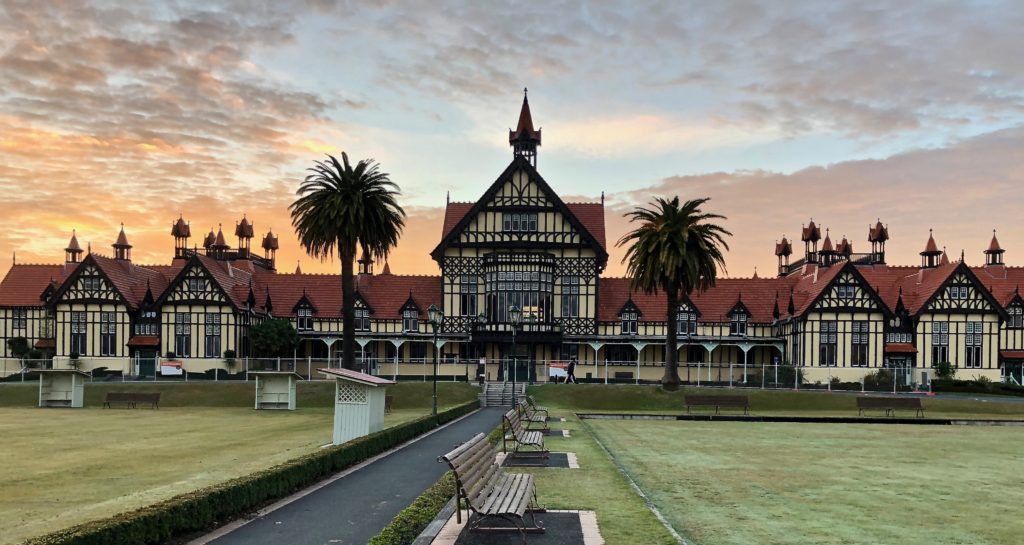
Rotorua: Bath House/Museum
The magnificent Bath House/Museum was closed, but I tried a sulfur bath at a spa nearby. It was pleasant, but no special feeling lingered. In the pool, I chatted with nonagenarian horticulturist who had been coming there every day for four decades and could still do some laps. Was it the chemicals in the bath or being outdoors every day for his work that kept him fit and limber? I guess it doesn’t matter as long as he keeps alert and able to move around easily.
After Rotorua, we drove down the North Island and stopped at Napier at Hawke Bay for a couple of hours. The town suffered a devastating earthquake in 1931 and was rebuilt with Art-Deco architecture, popular at the time. I took a guided walking tour of the downtown area to view the main buildings, some decorated with beautiful accents. Learning of the city’s reputation for good food, I was lucky to have one of the best meals of my visit (see below).

Napier: Art Deco
We spent the night in Wellington and the next day took the ferry across to the South Island. The journey took up most of the day and we reached our overnight destination, Blenheim at Cloudy Bay, late in the afternoon. It is in the Marlborough region, famous for its Sauvignon Blanc wines, but sadly, no time was allocated to visit a winery. Instead, we drove over the Kiakora mountains with snow on the peaks, stopping to view a rocky patch by Goose Bay where seals breed. Further South, I noticed a sign for Mt. Beautiful Winery as we passed Cheviot on our way to Christchurch. It is owned by Professor David Teese, who was on my doctoral thesis committee long ago, and is now the Director of the Center for Global Strategy and Governance at the Hass School of Business at Berkeley. Quite a coincidence!
After spending the night in Christchurch, we took a two-hour train journey up to Arthur’s pass, hugging a scenic river most of the way up the mountains. The coach picked us up at the station and drove us to Franz-Joseph where, next morning, sunny and bright, some travelers took a helicopter ride to Foxx Glacier. Having seen Himalayan glaciers, I chose instead to see the nocturnal Kiwi birds in a darkened indoor space. It was not easy to identify them in low light as their plumage blends with the foliage. They are about the size of small chickens, rounder and with long beaks to pick at insects. From Franz-Joseph, we drove over mountains and stopped to view Mt. Cook from the West with the glacier below it. Snow-capped mountains look majestic, especially in sunshine, however high they are. Further on, most of us took an exciting jet-boat ride along the Haast River through fiords, by streams and waterfalls. At the end, the pilot did a few exciting 360 degree spins. That was fun, although it turned the stomachs of a few in the front row.

Mt. Cook: View from the East
Along the route, we made “comfort” stops a few times every day in small towns where the main streets had shops, a supermarket, restaurants and several cafes, and importantly, clean and mostly free public toilets. The houses and yards looked in good shape, and nearby parks were well kept. Governance seemed civic, concerned about where and how people lived. Between the towns, the picture was not as good. Villages or clumps of small houses looked similar, perhaps prefabricated, and had untidy yards that conveyed the impression of relative poverty.
After driving past crystal clear Lakes Wanaka and Wahea, we reached Queenstown, a world-famous all-year resort town at lake Wakatipu. The views from a high point reached by a gondola ride were gorgeous–waters of a clear turquoise lake surrounded by greenery, especially on the peninsula jutting into it, and forested mountains rising, becoming rocky and peppered with patches of snow as they rose higher. Rain marred our second morning, but cleared up enough by the afternoon for us to take a steamship cruise on TSS Earnslaw to Colonel’s Homestead for a sumptuous buffet dinner followed by a sheep-shearing show. Apparently, champions can sheer a sheep in 40 seconds, and total over 700 in a day. They need to be fast as there are 27 million in the country, although down from 60 million a few decades ago.
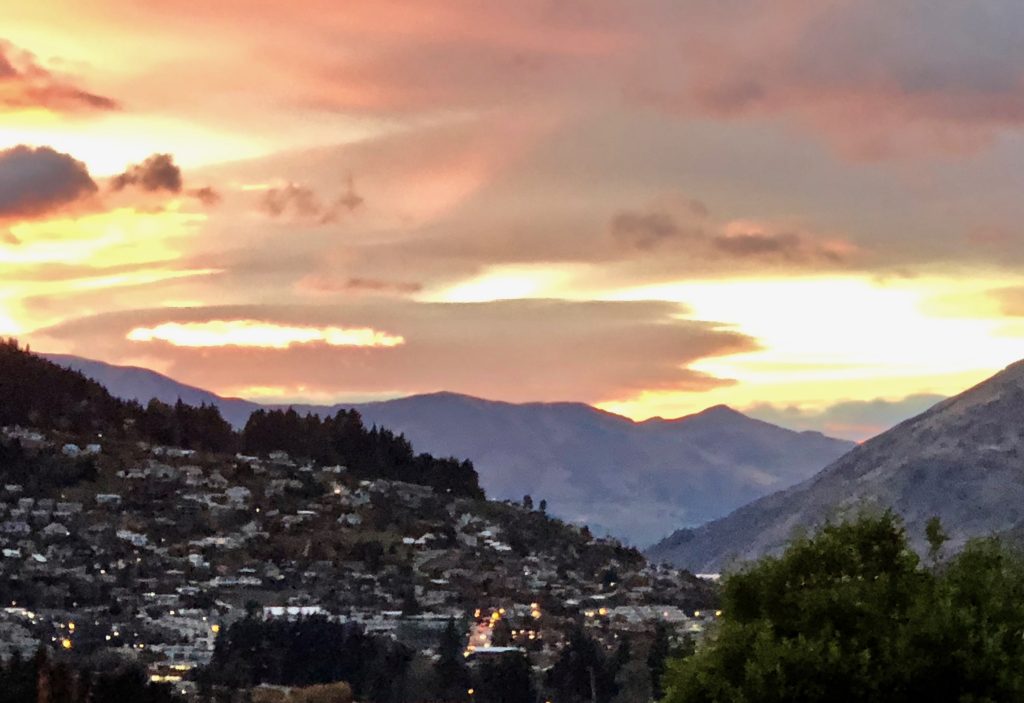
Queenstown Sunrise
For our visit to nearby Arrowtown, formerly a gold-mining town, we had to contend with rain again. Its museum had informative displays about that era when people from the British Isles and China came to join the rush. On one side of the entrance, it had an art display where I liked a painting and wanted to buy it, but could not because the museum declined to release it until the exhibition ended weeks later.
We headed to Te Anua, the staging town for a visit to Fiordland. On the next morning, the couple of hours drive to Milford Sound was especially difficult in the rain, down a winding, mountainous road. We sailed on a launch along the fiords, out to the Tasman Sea. Luckily, the rain abated, but the grey skies dampened the colors of the many and copious waterfalls and forested or snow-capped steep mountains on both sides. Still, the scenery was awesome. The water got choppy as we approached the Tasman Sea, but in compensation we saw a pod of dolphins, emerging from and ducking into the water, looking for food I imagine, or playing.
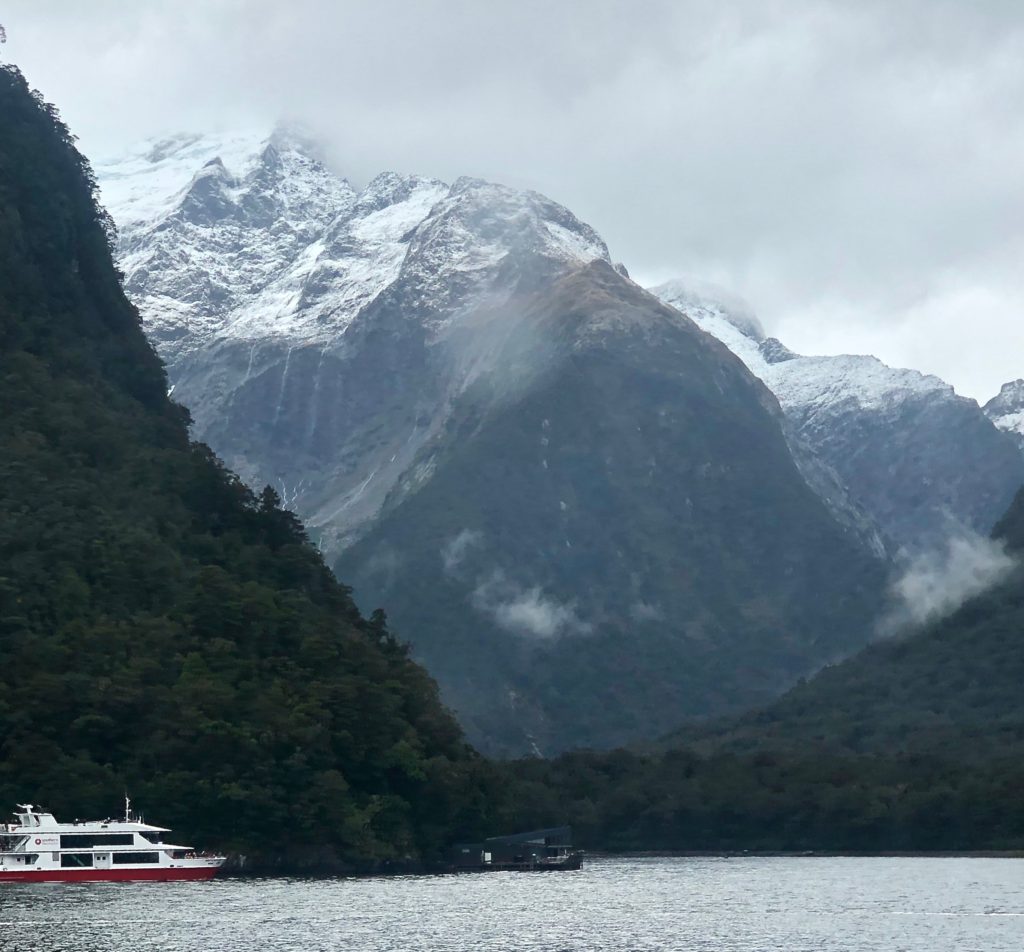
Milford Sound
On to Dunedin the next day, a town with a Scottish heritage–they were the first European settlers. It retains that tradition and we were treated to a charming, humorous “haggis” ceremony in the evening with bagpipes and all. Its remarkable railway station was built in “an eclectic, revived Flemish renaissance style… The southern end is dominated by the 37-meter clocktower visible from much of central Dunedin. The booking hall features a mosaic floor of almost 750,000 Minton tiles. A frieze of Royal Doulton porcelain runs around the balcony above it from which the floor’s design, featuring a locomotive and related symbols, can be clearly seen.” Upstairs, it had an interesting exhibit of paintings by local artists.
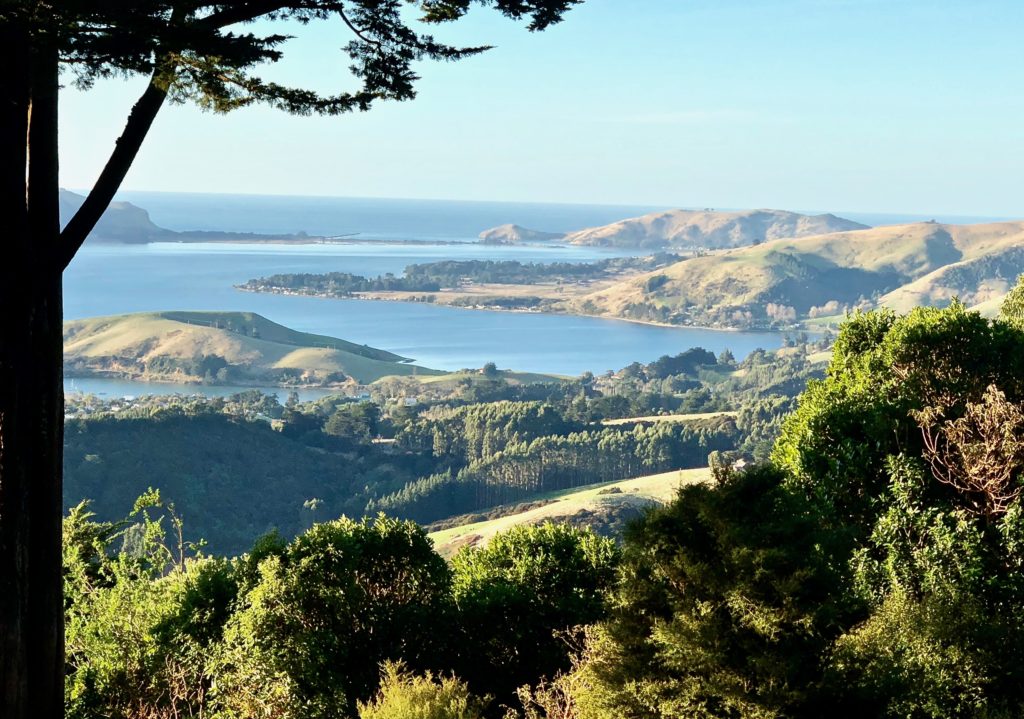
View from Lanarch Castle
Lanarch castle on a hill above the town has a great view of it, and was also a unique structure with an interesting family story. The downtown area has an unusually large number of cafés and restaurants because the city is home to the University of Otago and its 21,000 students. I stopped at a bar-restaurant in the evening for a glass of wine. The other patrons were mostly young people, presumably students, and some mature couples, who may have been academics or administrators at the university. It felt like being in a restaurant in Berkeley.
On the penultimate leg of the tour we drove to Twizel, but stopped at Oamaru for lunch, a small town with visually pleasing Victorian architecture and a precinct that had shops, galleries and restaurants for a tourist stop. We had hoped to see the Southern Lights at night from Twizel, but the weather did not cooperate. In compensation, the next morning on our way to Christchurch, we did get a clear view of Mt. Cook in sunshine from the East. The tour’s final night was celebrated with a dinner and music. The next morning, I caught a flight to Auckland where I connected to a flight to San Francisco.
Fine Food
As meat, dairy, seafood, and fruit comprise almost half of New Zealand’s exports, I assumed fine, fresh food would be available. But I was concerned that the country’s British heritage may have left a lingering influence on its cuisine. I need not have worried as modern, international gourmet cuisine was readily available. The Lonely Planet guidebook had good recommendations for restaurants.
Before I joined the tour group, I had dinner at Cassia, a modern Indian restaurant in downtown Auckland, near the harbor. I had Pani Puri (potato, chickpea mint), Celeriac Tart (yogurt, paneer and onion seed), and Te Matuku Oyster Pakora as starters; and Snapper, Kokam, Mustard, Coconut Flakes with Rice for the main dish. I thought the deep-fried oyster in Pakora batter was the most creative of the three starters, crunch through batter to the soft, spiced oyster. The firm Snapper was served in a thick dark, lightly spiced sauce that both the fish and rice absorbed, and the coconut flakes left a cleansing aftertaste. It was my best modern Indian meal in many years. As I had a couple of glasses of wine at my hotel’s pub earlier to socialize with locals, I did not have the capacity, sadly, to have some with dinner.
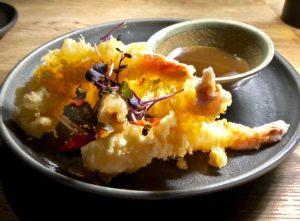
Tiger Prawns at Azabu
On the way south from the Bay of Islands towards Wellington, the tour stopped in Auckland for the night. I took that opportunity to try Azabu in the Ponsonby district. Its cuisine fused Japanese and Peruvian influences. I had Tempura Eggplant, Asian Slaw (bean sprouts, red onions, greens, toasted sesame seed) in an open bun as a starter; and Tiger Prawns with Aji Amarillo Mayo and Jalapeno Ponzu as my main dish. In the starter, the slaw overwhelmed the two rings of tempura eggplant—more would have given a better balance. The prawn’s texture was like lobster, meaty and sweetish, but the mayo with jalapeno added a nice kick. The Grayling Sauvignon Blanc from Marlborough was excellent, less grassy than is usual from that region, and paired well with the food.

Chickpea Tofu at Mister D
I had lunch at Mister D when we stopped in Napier. The walking tour of the town had whet my appetite nicely. I ordered a vegetarian dish that had two, two-tier round cakes of creamy chickpea “tofu”, surrounded by al dente young carrots, beans, broccolini, cucumber, crispy Kale and roasted, crunchy chickpeas placed on a bed of carrots pureed in local olive oil, and a sauce of ginger, soy, and star-anise poured over it. The sauce fused with the puree to give a tangy touch to the vegetables. Best Western cooking style vegetarian dish I have ever eaten.
I dined at Shepherd in Wellington on oysters as starters: one with Chardonnay Vinegar, Shallots and Cream and the other crunchy Korean fried with Kimchi Aioli–totally different tastes, but both delicious; followed by a White Fish with Coriander, Lime, Tomatillo, Apple and Buttermilk Sauce with a touch of Chili, which helped to spice the sauce that might have been bland without it. The gentle taste of Escarpment Pinot Gris from Marlborough paired well with the sauce. I chatted with the Indian-Fijian-New Zealander waitress about politics in Fiji and learned from her that the chef was from Ohio. When I accused him of giving us Trump, he denied responsibility by saying he had lived in New Zealand for a long time.
The Best Café in Dunedin was billed as offering the best Blue Cod Fish and Chips, and it did. The Blue Cod, in light batter, had a sweetish flavor, flakey texture and virtually no fishy odor. Guarding against soggy British-style chips, I asked for the hand-cut chips to be well-browned and they were—crisp outside and soft inside. The slaw that came with the order, however, did not have much taste.
Coach Tour
This was my first guided tour as a passenger. (I have accompanied two Stanford Alumni tours as the “academic leader”). We drove 2,600 miles, about 1,000 in the North Island and 1,600 in the South Island, in 18 days. The driver/guides, one for each island, were excellent drivers, negotiating a big coach on small winding and sometimes wet roads. Their commentary was informative and humorous, though at times I had difficulty with their accent. The logistics guide was great at herding 25-30 travelers through the ins and outs of hotels, restaurants and sights with humor and consideration.
The schedule was demanding. We had just 3 two-night stops in 18 nights. Getting up between 6-7 am and leaving hotels by 8-9 every day got tiring, and long hours on the coach were numbing, despite the beautiful scenery. I tried to walk or exercise as much as I could, but still felt caged. On the up side, we got to see the whole country, but on the down side, there was not enough time to experience it. Indeed, had I not arrived a few days early, and also strayed from the tour group for a few meals, I would not have met a New Zealander other than our guides and service staff at hotels, restaurants and shops. That was my problem with the Stanford tours as well. It’s like peering at a country rather than being in it.
The tour advertised 4 star hotel accommodations and delivered in the cities (Auckland, Wellington, Christchurch and Dunedin), but not in the other towns, where we lodged in motels, not bad, clean and comfortable, but 3 star levels. We were offered ample food for sure, mainly as buffets, where the fresh food, such as salads and fruits, was good, but the cooked fare was limp and tasteless. The few meals we ordered from the menu were the best.
Anyone interested in the detailed tour itinerary can see it by clicking on the link below:

